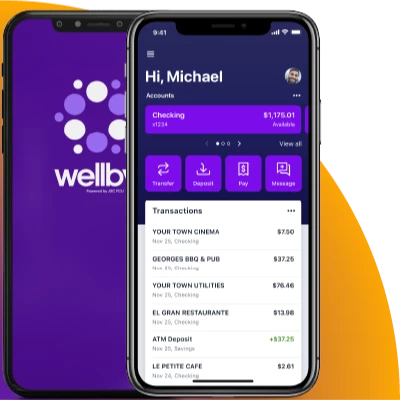February 6, 2025 | by Brian Truong

Understanding the Basics: Checking vs. Savings Account
September 22, 2023
By The Team at Wellby
When it comes to managing your money, many of you may wonder whether a checking or savings account is the right starting point. Whether you’re new to banking and this is your first step toward building smart money habits, or you have a basic awareness of these common personal banking accounts but want to take a deeper look at which options might be better for your needs, we want to help you understand the core differences between a checking and savings account so you can start your journey with confidence.
While both account types can help meet different needs in managing and staying on top of your finances, they don’t function the same way. Let's look at the key differences between checking and savings accounts, the common reasons many have for opening each account type, and how utilizing one or both accounts can help you meet your financial needs.
Managing Your Daily Finances with a Checking Account
 A checking account is a deposit account that allows you to easily withdraw money, make deposits, and conduct credit and debit transactions. The biggest advantage of having one is the ability to easily manage your day-to-day finances and common everyday purchases.
A checking account is a deposit account that allows you to easily withdraw money, make deposits, and conduct credit and debit transactions. The biggest advantage of having one is the ability to easily manage your day-to-day finances and common everyday purchases.
Typically, only a few documents are needed to open a checking account, including a state-issued ID and your social security number. After opening a checking account online or at your local branch, you'll receive a debit card, which allows you to make purchases and withdraw money from the ATM. You can also make balance transfers or pay bills online from your checking account.
Whether through cash or check, you can make deposits to your checking account as needed or by setting up direct deposit to ensure your account is funded monthly. You can also set up direct deposit with your job by providing your account and routing number. Then, your money will be deposited into your account and typically available each payday.
There are several types of checking accounts for different needs, including:
- Traditional checking accounts: A traditional checking account allows you to write checks, make debit card purchases, and withdraw cash from the ATM. This type of account is suitable for people who simply want an easier way to handle their money and make purchases. A traditional or “basic” checking account generally does not come with monthly fees.
- Interest-bearing checking accounts: With an interest-bearing checking account, you'll earn interest on your deposits. This is similar to how a savings or money market account works, with dividends paid out monthly based on the ending balance of your account.
- Student/Youth Checking Accounts These checking accounts are great for teens and college students. A student or youth checking account can offer unique benefits to those just starting their banking journey, such as no ATM or monthly service fees and low initial deposit requirements.
While there are a few common checking accounts, we discuss these different account types in further detail to help you determine how to choose the right checking account based on your financial needs.
Benefits of Opening a Checking Account
 The advantages of having a checking account include:
The advantages of having a checking account include:
- Access your funds easily through mobile/electronic pay and debit cards.
- Keep your money safe through protection from the Federal Deposit Insurance Corp (FDIC) or National Credit Union Association (NCUA).
- Deposit your paycheck automatically through direct deposit to reduce hassle and save a trip to your local branch.
- Typically, low deposit requirements to open your account.
- Transfer funds easily in a branch or through our online banking platform.
As you can see, there's a great selection of checking account types available to fit your personalized needs. Your checking account is a great starting point for building a relationship with your credit union and for managing your funds in a less stressful and more convenient way.
Building Toward Your Future with a Savings Account
 A savings account is a type of bank account that allows you to save money that you want to put aside for a big purchase, save for the future, or keep untouched for a “rainy day” emergency. That's why savings accounts are the perfect option for those who want to grow their money over time by earning interest.
A savings account is a type of bank account that allows you to save money that you want to put aside for a big purchase, save for the future, or keep untouched for a “rainy day” emergency. That's why savings accounts are the perfect option for those who want to grow their money over time by earning interest.
You can use a savings account to put money away for a specific purpose, such as saving for a new car, house, or vacation. Or, you can use your savings as an emergency fund. As we discussed with checking accounts, there are several documents needed to open a savings account that you can prepare beforehand while deciding which account type is right for you.
Like checking accounts, you can still withdraw and access money as needed with money transfers. However, most savings accounts don’t come with ATM or debit cards connected, so you won’t be able to access the funds through a digital payment on the go. The main appeal of a savings account is to earn interest on the funds you don't plan on spending so you can watch them grow over time.
The different types of savings accounts include:
- Traditional savings accounts: Basic or traditional savings accounts are a good option if you’re just starting your savings journey. A traditional savings account generally doesn’t have initial deposit amounts, monthly fees, or minimum balance requirements. While the interest you earn on a basic savings account may not be the highest available, it’s ideal to get started when you intend to put aside a few dollars each week or month to get things going.
- High-yield savings accounts: These accounts offer a higher APY than traditional ones but typically require higher initial deposits. High-yield savings accounts are ideal for people who want a more competitive APY and want to save or deposit larger sums of money to maximize the interest they’ll earn.
- CD (Certificate of Deposit) Accounts: CDs typically offer much higher interest rates than a traditional or high-yield savings account but restrict when you can access your funds. By selecting your term length, which typically varies between 6 months and 5 years, you essentially lock your money in for a guaranteed higher interest rate for the length of the term. This account is ideal when you know you won't need access to the funds throughout the term length and really want to make the most out of your savings by earning the highest interest available.
- Youth Savings Accounts: Youth savings or children's savings accounts are ideal for parents or guardians with young children who want to start them down the road toward building smart money habits. Oftentimes, these accounts come with parental controls, and family members can freely deposit funds into the account for things like allowances, birthday money, etc., so the child can learn about saving money.
Benefits of Opening a Savings Account
 Benefits of opening a savings account include:
Benefits of opening a savings account include:
- Earn compounding interest to grow your money over time.
- Transfer funds electronically while on the go as needed.
- Build your emergency fund or achieve short-term savings goals.
- Keep your money safe through protection from the Federal Deposit Insurance Corp (FDIC) or National Credit Union Association (NCUA).
Many advantages come with operating a savings account, but they're also things to consider to ensure this account type is right for you. For example, most savings accounts don't come with debit cards. So, you can't use them to make purchases online or in-store. We take a deeper look at the different types of savings accounts so you can be sure you’re making the right decision before opening your account.
Combining Savings & Checking to Reach Your Goals
 Finding the right account for your financial journey is key to helping you achieve your goals. But no rule says you have to choose just one account type.
Finding the right account for your financial journey is key to helping you achieve your goals. But no rule says you have to choose just one account type.
In fact, it’s generally advised to utilize multiple account types at once to ensure you’re utilizing the benefits of each account to their fullest. Why not utilize a checking and savings account to fully leverage the financial tools available to reach your goals and form better money habits?
For example, by opening both a savings and checking account, you’ll be able to save part of your monthly income automatically with direct deposit, ensuring you’re gaining compounding interest and growing your money for future goals while also having immediate access to the funds in your checking account for day-to-day purchases through your debit card or online.
Whatever your financial journey may require, our Wellby Financial team members are here to help you make the right decision for your future success. If you’re unsure which combination of accounts is best for your unique goals and dreams, we’ll be here to help support you as you grow, build, and thrive on your financial journey.
Related Topics
The Team at Wellby is a diverse group that is here to help you find the right financial solutions for your unique goals and budget. Our passion is people: our members, team members, and the communities we serve. We help people find solutions that support their financial well-being, allowing them to dream and prosper.
Related articles you might like
December 23, 2024 | by Brian Truong
Budgeting 101: Comparing Fixed and Variable Costs
December 12, 2024 | by Brian Truong







